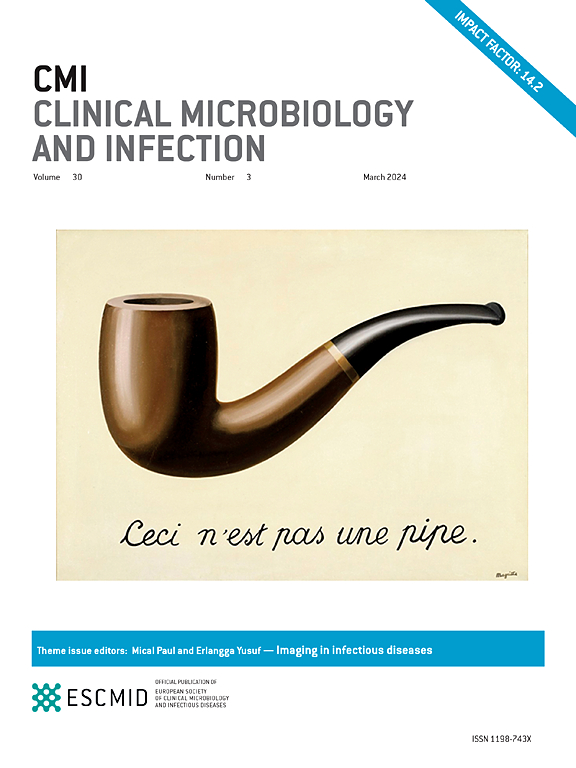大流行后时代对严重COVID-19的混合免疫和疫苗免疫——一项回顾性队列研究
IF 8.5
1区 医学
Q1 INFECTIOUS DISEASES
引用次数: 0
摘要
随着COVID-19已转变为地方病,有必要制定基于证据的有效战略,以减轻其对公共卫生的影响。本研究旨在通过考虑老年人的免疫史和个体特征,评估疫苗接种和混合免疫对严重疾病的保护作用,特别是在老年人中。方法:在一项回顾性队列研究中,分析了以色列卫生部(2022年5月至2024年4月)的数据,其中包括120万名至少接种过三剂COVID-19疫苗的60岁及以上个体。参与者被分为两组:混合免疫组和接种过疫苗但没有感染记录的组。使用泊松回归模型,对年龄、性别、波动周期和自上次免疫事件以来的时间进行调整,以估计严重COVID-19的风险。结果:与具有混合免疫的个体相比,未记录既往感染的个体的风险高出14.4倍(95% CI: 13.2至15.7)。70-80岁和80岁以上人群的风险分别是60-64岁人群的3.7倍(95% CI: 3.0 - 4.5)和11.3倍(95% CI: 9.3 - 13.7)。男性的风险是女性的1.6倍(95% CI: 1.5 - 1.7)。在严重的病例中,随着时间的推移,发病率会大幅下降。在3-6个月的队列中观察到免疫力下降,其发生严重疾病的可能性是0-3个月队列的1.8倍(95% CI: 1.5至2.2)。此后没有观察到免疫力进一步下降。结论:在这个大流行后阶段,具有混合免疫的个体患严重疾病的风险显著降低。这些发现支持对没有混合免疫的个体优先采取保护策略,并表明保护至少可以持续一年。本文章由计算机程序翻译,如有差异,请以英文原文为准。
Hybrid and vaccination immunity against severe COVID-19 in the post-pandemic era—a retrospective cohort study
Objectives
As COVID-19 has transitioned to an endemic disease, there is a need for evidence-based effective strategies to mitigate its public health impacts. This study aims to evaluate the protection offered by vaccination and hybrid immunity, particularly among the elderly, against severe disease by considering their immunological history and individual characteristics.
Methods
In a retrospective cohort study, data from the Israeli Ministry of Health (May 2022–April 2024) were analysed, including 1.2 million individuals aged 60 years and older who received at least three COVID-19 vaccine doses. Participants were categorized into two groups: those with hybrid immunity and those with vaccination and without documented previous infection. Poisson regression models, adjusted for age, sex, wave period, and time since the last immunological event, were used to estimate the risk of severe COVID-19.
Results
Individuals without documented previous infection are 14.4 (95% CI, 13.2−15.7) times more at risk compared with those with hybrid immunity. Those aged 70–80 and 80+ are 3.7 (95% CI, 3.0–4.5) and 11.3 (95% CI, 9.3–13.7) times more at risk, respectively, than those aged 60–64. Males are at 1.6 (95% CI, 1.5–1.7) times higher risk than females. There is a substantial decrease over time in severe cases. Waning immunity is observed in the 3–6 months cohort, which is 1.8 (95% CI, 1.5–2.2) times more likely to develop severe disease than the 0–3 months cohort. No further waning immunity was observed after that.
Discussion
At this post-pandemic stage, individuals with hybrid immunity had a significantly lower risk of severe disease. These findings support the prioritization of protection strategies for individuals without hybrid immunity and suggest that protection remains durable for at least one year.
求助全文
通过发布文献求助,成功后即可免费获取论文全文。
去求助
来源期刊
CiteScore
25.30
自引率
2.10%
发文量
441
审稿时长
2-4 weeks
期刊介绍:
Clinical Microbiology and Infection (CMI) is a monthly journal published by the European Society of Clinical Microbiology and Infectious Diseases. It focuses on peer-reviewed papers covering basic and applied research in microbiology, infectious diseases, virology, parasitology, immunology, and epidemiology as they relate to therapy and diagnostics.

 求助内容:
求助内容: 应助结果提醒方式:
应助结果提醒方式:


